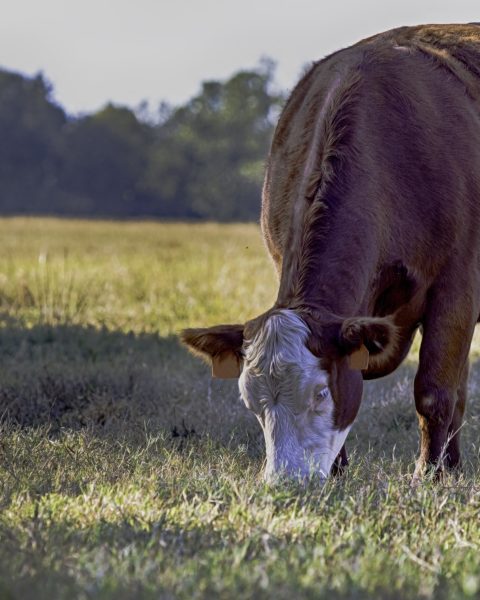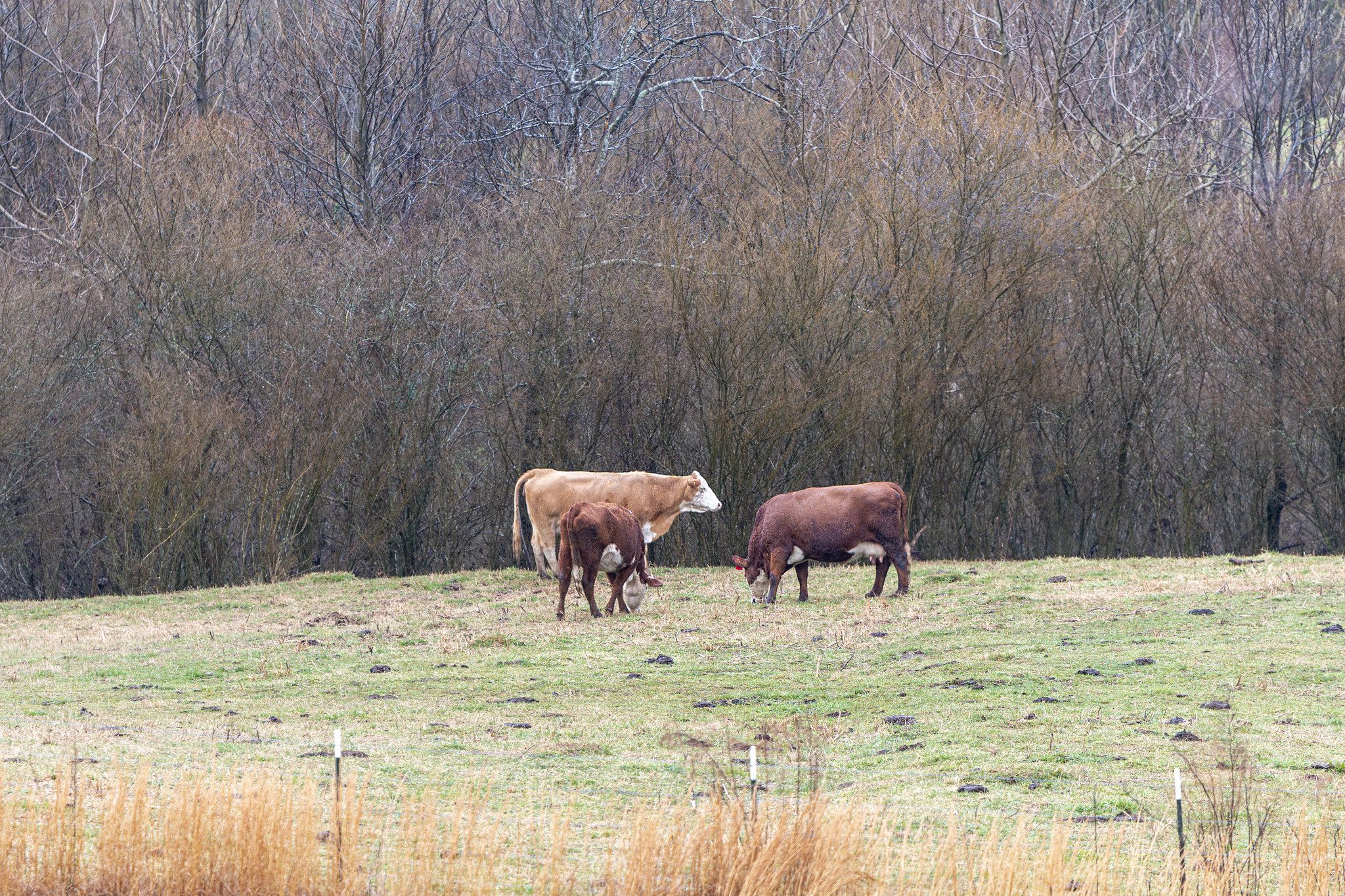Beef

Learn key management practices to improve sustainability in small herd operations.
 Cow-calf operation sustainability involves the efficient use of resources on-farm to improve herd profitability and farm productivity now and for future generations. For operations with less than fifty head of cattle, it is especially important to focus on herd processes that improve time and resource management. The following are key management practices you can implement to improve herd sustainability.
Cow-calf operation sustainability involves the efficient use of resources on-farm to improve herd profitability and farm productivity now and for future generations. For operations with less than fifty head of cattle, it is especially important to focus on herd processes that improve time and resource management. The following are key management practices you can implement to improve herd sustainability.
Keep Cattle Healthy
A good herd health program is essential to any farm management operation. Many producers think about vaccinations, deworming, or other treatment strategies when developing a plan. Yet practices that decrease handling and environmental stresses on the herd can influence health, as well. You need a veterinarian who can work closely with you to best meet the requirements of the herd and ensure that all herd health practices occur at the proper time.
Maintain Accurate Records
Animal identification is especially important for evaluating herd inventory, maintaining biosecurity, and tracking the performance of animals in the herd. Individual identification records should include a calf’s place of origin, date of birth, and health care records indicating vaccinations and other treatments given.
Numerous record-keeping resources are available. Among these are the National Cattlemen’s Beef Association Integrated Resource Management Redbook, online software, and mobile applications. Many resources include features that allow users to add photos and detailed information regarding the herd for quick reference. These tools help producers to keep track of pregnancy data, calving data, dam information such as calving interval and calf weaning weight, sire information, and pasture usage. See Alabama Extension publication “Beef Cattle Record Keeping Basics” (ANR-2488) for more information on beef cattle record keeping.
Define a Calving Season
A controlled calving season can save time, labor, and resources for a small cattle producer (table 1). Managing the cow herd to calve in 90 days or less can help with the following:
- Forages. Calving can be timed to optimize forage availability and nutritive value.
- Nutrition. A more targeted feeding program can be established since animals are in the same stage of production (pregnant, lactating, etc.).
- Record keeping. Cow records can be used more efficiently to select replacement heifers and to cull cows.
- Health maintenance. Cattle require less handling for vaccinations and other health-related activities.
- Marketing. The calf crop is more uniform at the time of marketing because calves are closer in age and stage of growth.
Table 1. Year-Round Herd Management Time Line for Winter-, Spring-, and Fall-Calving Beef Herds
| Winter Calving Season Planning Timeline | Spring Calving Season Planning Timeline | Fall Calving Season Planning Timeline |
|---|---|---|
| Calving Season Jan-March | Bred Heifers Calving Mid Feb | Remove Bulls by Mid March |
| Breeding Heifers Early March & Cows Late March | Calving Season March-May | Pregnancy Check Mid May |
| Remove Bulls by Mid June | Breeding Heifers Early May & Cows Late May | Wean & Weigh Calves for Adjusted Weaning Weights by Mid May |
| Pregnancy Check Mid Aug | Remove Bulls by Mid Aug | Bred Heifers Calving Mid Sep |
| Wean & Weigh Calves for Adjusted Weaning Weights by Mid Aug | Pregnancy Check Mid Oct | Calving Season Oct-Dec |
| Bred Heifers Calving Mid Dec | Wean & Weigh Calves for Adjusted Weaning Weights by Mid Oct | Breeding Heifers Early Dec & Cows Late Dec |
Implement Crossbreeding
Crossbreeding can improve production efficiency by increasing hybrid vigor (heterosis). Hybrid vigor is the increase in production traits, such as growth, fertility, and longevity, that occurs from breeding genetically different animals of separate breeds. Crossbreeding allows a cattle producer to blend complementary strengths and superior traits, including carcass characteristics, growth rates, and reproductive performance, to produce calves that can perform at a higher level than the parental breeds.
To have a defined direction in the development of a crossbreeding system, consider the operational environment, resources, marketability and marketing plan, complementary strengths, and availability of breeds. Set goals will guide which breeds to apply in your crossbreeding system. Breeds selected should complement each other’s strengths and be implemented to produce uniform feeder calves. Consider production traits such as calving ease, weaning and yearling weight growth, milking ability, and carcass qualities in the selection of breeds to apply in a crossbreeding system.
Consider Growth-Promoting Implants
Implants can complement other good management practices such as crossbreeding, adequate nutrition, castration, and vaccinations to improve gains in growing beef calves. Implants are small pellets containing slow-release hormones that increase muscle growth over time. They are inserted into the ear of a calf. Steer calves and heifers to be sold to the feedlot should be implanted; replacement heifers should not receive growth-promoting implants. See Alabama Extension publication “Alabama Beef Quality Assurance: Implanting Cattle Properly” (ANR-1281) for more information on implanting beef calves.
Castrate Bull Calves
Buyers of feeder cattle prefer castrated steers over intact bull calves. Bull calves that are not intended for breeding purposes should be castrated before the age of 3 months or at the first available handling opportunity beyond this age. Calves castrated at a younger age recover more quickly, and the procedure is easier to perform. Cattle buyers often prefer calves that have been surgically castrated. Alternatively, calves can be castrated using an elastrator.
Dehorn Calves
Dehorning is a cost-effective practice that can add value to feeder cattle and reduce the risk of injury to those handling cattle. Calves should be dehorned at the earliest age that is practical. Young calves tend to recover more quickly and have fewer complications than those dehorned at an older age. It is important to properly restrain calves before dehorning.
Additional Resources
Alabama Beef Cattle Improvement Association
Alabama Beef Systems Extension Program
Alabama Cattlemen’s Association
Alabama Farmers Federation
Beef Quality Assurance Program
 Kim Mullenix, Extension Specialist, Associate Professor; Michelle Elmore, Associate Extension Professor; and Soren Rodning, Extension Specialist, Professor, all in Animal Sciences and Forages, Auburn University
Kim Mullenix, Extension Specialist, Associate Professor; Michelle Elmore, Associate Extension Professor; and Soren Rodning, Extension Specialist, Professor, all in Animal Sciences and Forages, Auburn University
Revised February 2022, Beef Herd Management Strategies, ANR-2415

